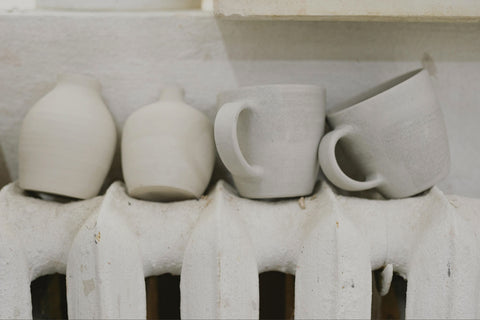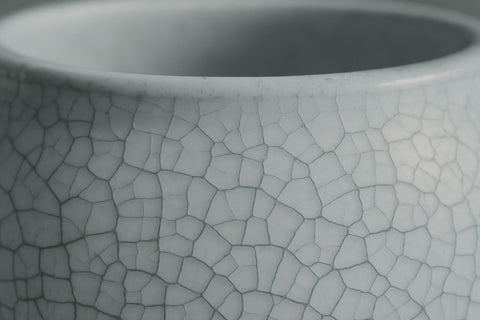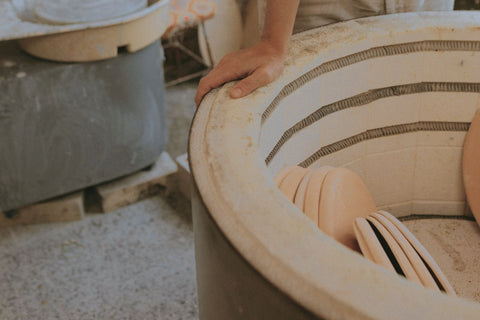introduction: why is drying clay completely before the first firing so important?
drying clay all the way through before the first firing is a step that often gets rushed, especially by beginners, but it’s one of the most important. here’s why it matters and how to do it right.

why let clay air dry?
- preventing cracks and explosions: moisture trapped inside clay can cause cracks or even explosions in the kiln. as water turns to steam, it expands—and if it’s trapped, it forces its way out, damaging the piece.
- structural integrity: properly dried clay holds its shape better during firing. it’s less likely to slump, warp, or fall apart under high heat.
- even firing: clay that’s dried evenly shrinks evenly too. this helps prevent warping, cracking, and unpredictable results during the firing.
- time and energy efficiency: dry clay takes less time and energy to fire. wet clay makes the kiln work harder to burn off that moisture.
- glaze adherence: glaze sticks better to dry clay. if your clay is even slightly damp, glaze can go on unevenly or flake off before firing.
the drying process
- slow and even drying: cover your piece with plastic or drop cloth to slow the drying process. grocery bags work well for small items; dry cleaning bags for larger ones. make sure the cover is intact with no holes over key areas.
- adjust exposure: if one part dries faster (like the rim of a bowl), cut a hole in the cover to expose the slower-drying section instead. if you added elements like handles, wrap those attachments well to reduce the chance of cracks.
- check dryness by touch: if it feels cool, there’s still moisture. thick pieces need more time - make sure the inside is just as dry as the outside.
- a damp box helps: a damp box is a great way to control drying, especially in dry seasons. you can make your own or buy one online. The Clay Plant has a good one based on Danny Meisinger’s method.

air drying by clay type: porcelain vs. stoneware
different clays dry at different rates. knowing how your clay behaves helps you avoid problems.
porcelain
-
dries faster on the surface because it has finer particles and less plasticity, which can cause the outer layer to dry and shrink faster than the inside.
-
this uneven drying is what makes porcelain more prone to cracking - not that it dries slower overall, but that it dries inconsistently unless slowed intentionally.
-
needs slower drying to prevent surface tension from cracking the piece.
stoneware
-
often has more grog or sand, which adds structure and allows moisture to evaporate more evenly throughout the body.
-
this makes it less prone to cracking and more forgiving, but not necessarily slower or faster than porcelain - just more stable during drying.
porcelain
-
dries faster on the surface because it has finer particles and less plasticity, which can cause the outer layer to dry and shrink faster than the inside.
-
this uneven drying is what makes porcelain more prone to cracking - not that it dries slower overall, but that it dries inconsistently unless slowed intentionally.
-
needs slower drying to prevent surface tension from cracking the piece.
- something I have found helpful during the winter in my at-home studio is a good humidifier. I like to let my covered porcelain dry as slowly as possible, and I have found that adding a humidifier to the process further mitigates cracking in the drying process.
takeaway
porcelain needs to be dried more slowly to avoid surface cracking. stoneware is less finicky but still needs even exposure, especially for thick pieces.

greenware or bisqueware?
if you’re juggling multiple pieces, it’s easy to lose track. here’s how to tell the difference between greenware (dried clay) and bisqueware (fired once).
greenware (not yet fired):
-
color is usually similar to the original wet clay, just lighter
-
fragile and easy to scratch or dent
-
sounds dull when tapped with a metal tool
-
softens if it gets wet again
bisqueware (fired once):
-
color changes, often whiter or more muted
-
harder surface that doesn’t scratch easily
-
rings when tapped with a metal pin tool
-
doesn’t soften with water, but still absorbs it - don’t soak before glazing or the glaze won’t stick properly
knowing these signs helps you track your progress and avoid glazing mistakes. if something cracks after glaze firing, the Japanese art form of repair, Kintsugi, is always an option, but ideally, you want to prevent cracks in the first place.
conclusion
drying your clay all the way through before firing isn’t optional—it’s essential. taking the time to do it right saves you from broken pieces, wasted glaze, and unnecessary rework later. it’s one of the simplest ways to set your pottery up for success.





